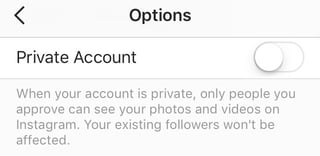For businesses especially, it's a way to humanize your brand, recruit future employees, showcase your product and company culture, delight customers, and generate new business. Once you've created and optimized your profile, have someone manning it, and know a thing or two about phone photography and photo editing, it's time to start posting. To start posting on Instagram, first download this social media content calendar template and start planning out your Instagram posts. While this doesn't seem like the smoothest way to curate photos, it's actually the easiest for the people sending you photos -- and the easier you can make it for them to send content, the more content you'll get. The voice is filled with personality -- note the cheeky hashtag #letsbefrank, which often follows captions like this one. (Read this guide on how hashtags work on Instagram for more detailed tips.) To find the hashtags your audience might be using, do a little research on relevant hashtags in your niche or industry. 11) Share Instagram Stories and live videos. Also, be sure to promote your Instagram account on your other social media accounts. Let those followers know you're on Instagram and encourage them to follow you there by including a link to your Instagram account in the bios and posts of those other social media accounts.

You might already know that Instagram is a growing channel that lets individuals and businesses alike expand their brand. For businesses especially, it’s a way to humanize your brand, recruit future employees, showcase your product and company culture, delight customers, and generate new business.
But here’s the deal: Unless you’re famous, it’s really hard to amass a huge following on Instagram without some hard work.
For the average person or business, growing your following takes time and attention on a daily basis. And although you may be tempted to buy your first several followers to get the ball rolling, purchased followers are either fake or low-quality profiles — so they really serve no purpose except to artificially inflate your follower count. Don’t count on any meaningful engagement or business interactions from these folks.
Luckily, there are a few things you can do right away to collect at least 1,000 quality followers for your personal or professional Instagram account. It’s all about knowing where to invest your time and effort — which is exactly what we’ll show you in this post.
Let’s go through how to gain those first 1,000 followers, from creating a follow-worthy Instagram profile to using contests to staying true to your brand. (Looking for inspiration? Read this blog post to browse through 17 of the best brands on Instagram.)
How to Get More Followers on Instagram
1) Create and optimize your profile.
First things first: Customize your Instagram profile to make it look good, tell your potential followers who you are, and give them a reason to follow you.
How? Start by making sure your username is recognizable and easily searchable — like your business name. If your business name is already taken, try keeping your business name as the first part of your username so that people searching for your business are more likely to come across you. For example, the Australian activewear line Lorna Jane uses the username @lornajaneactive.
(Note: Make sure to add your full business name to the “Name” field in the “Options” section — the gear button on iOS, or three dots on Android). This will appear under your profile picture and under your username in search.
Next, make sure your profile is public. To make your profile public, open Instagram, open “Options,” and make sure “Private Account” is turned off.

Next, choose a profile picture that’s on-brand with your other social networks, like your company logo.
Then, fill your bio with delightful, actionable, and informative information about your brand. Information like this lets people know what you’re about and gives them a reason to follow you. Include who you are and what you do, and be sure to add a hint of personality. Here are a few examples for inspiration:
- @WeWork: “Make a life, not just a living.”
- @CalifiaFarms: “Crafting, concocting and cold-brewing up a delicious, plant-based future. Califia Farms Loves You Back”
Next, add a link to your bio to make it easy for people to go straight from Instagram to your website if they want to. The space allotted for URLs is precious real estate because it’s the only place within Instagram where you can place a clickable link, so use it wisely. We recommend using a shortened, customized Bitly link to make it more clickable.
Finally, enable notifications so you can see when people share or comment on your photos. This’ll let you engage with them more quickly — just like a lot of companies do on Twitter. To enable notifications, go to “Options” and then “Push Notification Settings.” Select “From Everyone” for every category.
A word to the wise: We don’t recommend you link your Instagram account to Twitter and Facebook so your Instagram posts are automatically published on those other accounts. Post types are different.
2) Designate a content creator.
Just like there should be one (maybe two) people managing your other social media accounts, there should only be one or two people managing your Instagram account. If possible, choose someone who has experience using a personal Instagram account, and therefore “gets” the platform — and be sure they know all the handy features Instagram has to offer.
If you work for a large organization, you might find that a lot of people want to have a say in what’s posted. That’s when an organized request or guidelines document comes in hand. This document should inform people how to request a post on your Instagram account, when, the value of the post, and why.
3) Brush up on your photography and editing skills.
On Instagram, post quality matters. A lot. Your Twitter followers might forgive a few bad tweets, but a bad photo on Instagram is a big no-no. By no means do you have to take a photography course to be a good Instagram poster — nor do you have to practice for weeks before you start. But you should get familiar with basic photography tips and photo editing apps.
Photography Skills
Since Instagram is a mobile app, chances are, most of the photos you post to Instagram will be taken on your mobile device. That’s not just okay; it’s expected. While some brands use professional photography for their Instagram photos, most use smartphones — and that’s the vibe that Instagram is meant for, anyway.
Start by reading this blog post on tips for taking great pictures on your smartphone. Here are some highlights:
- Focus on one subject at a time.
- Embrace negative space.
- Find interesting perspectives.
- Look for symmetry.
- Capture small details.
- Make your followers laugh.
(Click here for all 18 tips on taking great pictures with your smartphone.)
Photo Editing Skills
Instagram has some basic editing capabilities, but oftentimes, they aren’t adequate to make a picture really, really great. Most of your photos should go through at least one or two other photo editing apps on your mobile phone before you open them in Instagram for the first time.
Read this blog post for a list of the best photo and video editing apps for mobile devices. These apps will let you do everything from sharpening specific parts of a photo to brightening certain hues to make your photo look fresher.
4) Start posting.
Once you’ve created and optimized your profile, have someone manning it, and know a thing or two about phone photography and photo editing, it’s time to start posting. It’s a good idea to have a solid number of great posts up — maybe 15 or so — before you start really engaging people and working down this list. That way, when people visit your profile, they’ll see a full screen of photos instead of just a handful, so they know you’ll be posting great content regularly.
To start posting on Instagram, first download this social media content calendar template and start planning out your Instagram posts. Over time, you’ll want to build up a backlog of photos for times of need, like the weekends or when you go on vacation.
Keep your target persona in mind when you first start planning out your posting schedule, as that can drastically change your posting timing and frequency — especially if you’re targeting an audience in a different time zone. (Download this free template for creating buyer personas if you don’t have a few already.)
While optimizing your schedule for your specific audience will take time and experimentation, we created this infographic using recent data on the best times to publish on every social media network to get you started. Our sources found that the very best times to post on Instagram were Mondays and Thursdays at any time except between 3:00–4:00 p.m. for the time zone of your target persona. (For a United States audience, your best bet is to combine Eastern and Central time zones, as they represent almost 80% of the U.S. population. For audiences located outside the U.S., use whichever time zones your target audience uses.)
However, because Instagram is primarily an app for use on mobile devices, users tend to use the network all the time, any time — although many users engage with content more during off-work hours than during the workday. Some businesses have also seen success with posting at 2:00 a.m., 5:00 p.m., and Wednesdays at 7:00 p.m. Experiment with these to see if they work with your audience.
5) Curate some of your content.
Although it’s best to have only one or two people manning your…
COMMENTS